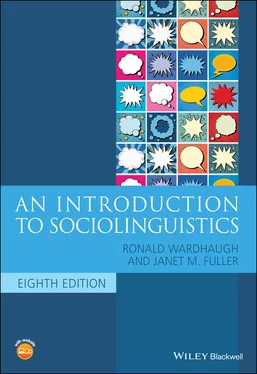One English accent has achieved a certain eminence, the accent known as Received Pronunciation(RP), the accent of perhaps as few as 3 percent of those who live in England. (The ‘received’ in Received Pronunciation is a little bit of old‐fashioned snobbery: it meant the accent allowed one to be received into the ‘better’ parts of society!) This accent is of fairly recent origin (see Mugglestone 1995), becoming established as prestigious only in the late nineteenth century and not even given its current label until the 1920s. In the United Kingdom at least, it is ‘usually associated with a higher social or educational background, with the BBC and the professions, and [is] most commonly taught to students learning English as a foreign language’ (Wakelin 1977, 5). Those who use this accent are often regarded as speaking ‘unaccented’ English because it lacks a regional association within England; we return to this point below. Other names for this accent are the Queen’s English, Oxford English, and BBC English. However, there is no unanimous agreement that the Queen does in fact use RP. Harrington et al. (2000) point out that an acoustic analysis of her Christmas broadcasts since 1952 showed a drift in her accent ‘toward one that is characteristic of speakers who are younger and/or lower in the social hierarchy.’ She ‘no longer speaks the Queen’s English of the 1950s.’ Today, too, a wide variety of accents can be found at Oxford University, and regional accents also feature prominently in the various BBC services.
The most generalized accent in North America is sometimes referred to as Newscaster English, the accent associated with announcers on the major television networks, or General American, a term which emphasizes its widespread acceptance and lack of regional association (see the website for this chapter to find a link to the discussion of Standard American English in the Do You Speak American? PBS production). Lippi‐Green (2012, 62) endorses the use of the term SAE ( Standard American English), while recognizing that it is a ‘mythical’ beast and idealizes a homogeneous variety. There is no official definition of what forms are included in SAE in terms of accent or grammar; as noted by Pinker (2012), ‘The rules of standard English are not legislated by a tribunal but emerge as an implicit consensus within a virtual community of writers, readers, and editors. That consensus can change over time in a process as unplanned and uncontrollable as the vagaries of fashion.’ It is also often recognized that there are regional standards in US English; for example, while r‐lessnessmay be considered standard in Boston or Atlanta, it is not in Chicago; / ai/ monophthongization(e.g., the pronunciation of the vowel in the pronoun ‘I’ to sound more like ‘Ah’) is heard by newscasters in southeastern parts of the United States but not farther north or west.
Of course, there are many other varieties of English spoken around the world, in countries where English is the majority language in all or some regions (e.g., Canada, Australia, New Zealand) or in multilingual countries where it is one of several languages in widespread use (e.g., India, South Africa, Malaysia). In these contexts there are also accents which are considered standard.
As a final observation we must reiterate that it is impossible to speak English (or any other language) without an accent. There is no such thing as ‘unaccented English.’ RP is an accent, a social one rather than a regional one. However, we must note that there are different evaluations of the different accents, evaluations arising from social factors not linguistic ones. Matsuda (1991, 1361) says it is really an issue of power: ‘When … parties are in a relationship of domination and subordination we tend to say that the dominant is normal, and the subordinate is different from normal. And so it is with accent… . People in power are perceived as speaking normal, unaccented English. Any speech that is different from that constructed norm is called an accent.’ We will return to such matters in the next chapter in our discussion of language attitudes and ideologies. Further, we will address the use of English as a lingua franca (i.e., non‐native Englishes) in chapter 9.
Exploration 2.3 The Standard and Accents
Drawing on this discussion of English accents, discuss accents of other languages you are familiar with: is there a prestigious accent associated with a particular region or is it seen as regionally neutral? Are there different ways of speaking the Standard in different regions? Have there been changes or developments in what is considered Standard? Give specific examples where possible.
The term dialect can also be used to describe differences in speech associated with various social groups or classes. An immediate problem is that of defining social group(see chapter 3) or social class(see chapter 5). Proper weight needs to be given to the various factors that can be used to determine social position, for example, occupation, place of residence, education, income, ‘new’ versus ‘old’ money, racial or ethnic category, national or cultural background, caste, religion, and so on. Such factors as these do appear to be related to how people speak.
Whereas regional dialects are geographically based, social dialects originate among social groups and are related to a variety of factors, the principal ones apparently being social class, religion, and race/ethnicity. In a study of the role of religion in variation in Arabic across Arabic‐speaking countries, Germanos and Miller (2015, 96) note that ‘even tiny sociolinguistic variation (including salutations and terms of address) will often be enough to identify a speaker as Muslim, Jew or Christian in the same way that he will also be identified as urban or rural, as coming from such and such region, as belonging to popular or middle‐class etc.’
Such studies in social dialectology, the term used to refer to this branch of linguistic study, examine how ways of speaking are linked to social differences within a particular region. Socioeconomic class is a main factor which will be addressed in chapter 5. Another factor in social dialectology which has received a great deal of attention is race/ethnicity; later in this chapter we will focus on African American Vernacular English, a variety which has been studied extensively by sociolinguists. First, however, we will introduce a German social dialect which is controversial both in German society and among linguists, a case which brings to the forefront the concerns inherent to social dialectology.
Kiezdeutsch ‘neighborhood German’
The term Dialekt , ‘dialect’ in German, as mentioned above, has historically been used solely to refer to regional varieties. While sometimes stigmatized, these dialects are at the same time integral to regional identities and seen as deeply, essentially German. While a body of literature on Gastarbeiterdeutsch (‘guest worker German’) emerged beginning in the 1970s, this variety was identified as a second language or a ‘pidginized’ variety of German, and very clearly spoken only by immigrants (e.g., Keim 1978; Pfaff 1980), and thus, not a German Dialekt . Subsequently, a body of research about multilingual language practices of multiethnic groups of urban youths in Germany showed that multilingual practices were common among urban youths of many backgrounds, including those whose families had long been in Germany (e.g., Auer and Dirim 2003; Kallmeyer and Keim 2003). While this research did show that such practices were not unique to children of immigrant background, it also did not suggest that multilingual discourse was something quintessentially German. However, when Kiezdeutsch , a way of speaking associated with multiethnic neighborhoods, was described as a German dialect (Wiese 2010, 2012), resistance to the idea of recognizing this way of speaking as a variety of the German language became apparent. The controversies surrounding this work, both in academic circles and in public discourses, exemplify the issues in social dialects in general. These issues include the label applied to the variety, identifying the features of the variety, correlations with demographic factors, and the process of the development.
Читать дальше




![Andrew Radford - Linguistics An Introduction [Second Edition]](/books/397851/andrew-radford-linguistics-an-introduction-second-thumb.webp)







